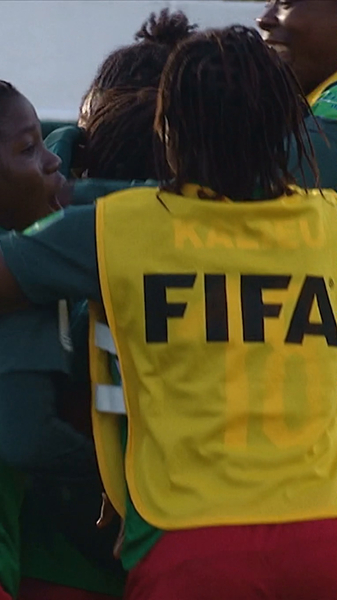Women's football
When the COVID-19 pandemic struck, there were fears that women’s football would suffer disproportionally within the game.
FIFA was determined that this would not happen and 2021 saw an explosion in the development of women’s football across the world.
FIFA Women’s World Cup breaks new ground
The FIFA Women’s World Cup Australia & New Zealand 2023, the first to be held across two confederations (the AFC and OFC) and with 32 teams competing, is a major milestone in the development of women’s football.
With qualification matches being played across the globe, more female footballers than ever are dreaming of playing at FIFA’s flagship women’s tournament.
Securing the future of women’s football
FIFA’s unparalleled COVID-19 Relief Plan has provided an opportunity to drive positive change in women’s football.
As part of the relief plan, USD 500,000 has been made available to every member association for use specifically in the women’s game. These funds have been used to protect existing leagues and clubs, support diverse development projects and provide peace of mind for footballers at all levels of the game.
A key requirement of FIFA’s funding is that member associations must include a strategic development plan for women’s football as part of their claim. This ensures that women’s football remains at the forefront of their long-term plans.
Future of men and women’s games entwined
In September 2021, double FIFA Women’s World Cup-winning coach Jill Ellis was entrusted with leading the Technical Advisory Group on the future of women’s football.
Alongside FIFA Chief of Global Football Development Arsène Wenger, Ellis is heading the discussions and consultations in relation to the future International Match Calendars (IMCs).
Both Ellis and Wenger have stressed their aims of ensuring that men’s and women’s football coexist when any changes to the IMCs are considered.
“I think our fan bases cross over. You see women at men’s matches, and you see young boys and men at women’s matches. I agree with Arsène: we want to grow both platforms.”
Setting the pace
FIFA published a landmark report in June 2021 on the development and professionalisation of the elite women’s football landscape around the world, the first time such a level of analysis had been achieved in the women’s game.
The FIFA Benchmarking Report: Women’s Football provided insights into several key areas of the elite women’s game, including sporting matters, finance, fan engagement and player-related matters. The information came from a survey completed by a selection of 30 of the top-tier women’s football leagues from around the world and 282 of their respective clubs.
“Boosting the development and growth of women’s football – on and off the pitch – is a key commitment and top priority for FIFA. As the interest continues to increase, we must focus on developing an in-depth understanding of the elite women’s football landscape.”
Key findings include:
For leagues in which 80% or more participating clubs had a girls’ youth structure, the average national-team ranking was 13, compared to a ranking of 28 for all other leagues.
Leagues with both a club licensing system and financial controls had a higher proportion of clubs that were profitable or broke even (36% v. 32%) and a higher average club revenue (USD 0.9m v. USD 0.3m).
In 65% of leagues surveyed, teams with the highest-qualified coaches outperformed other teams, underlining the importance of coach education and development in the women’s game.
Clubs with better access to a higher number and quality of facilities outperformed other clubs in their league: 50% of such teams were league champions in the previous five years, compared with only 23% for all other clubs.
Broadcasting women’s football on traditional and digital platforms represented a significant growth opportunity, with broadcast income accounting for an average of 6% of revenue for clubs and 18% of revenue for leagues that were surveyed.
Teams offering a season ticket had higher average league attendances (1,400 v. 1,000) and earned a higher revenue (USD 0.8m v. USD 0.3m).
Clubs with a written strategy for women’s football tended to have a higher average club revenue (USD 0.6m v. USD 0.3m), more facilities available to the first team and higher match attendances (1,400 v. 700).
Leagues that negotiated broadcast rights exclusively for the women’s league generated, on average, USD 0.7m revenue from broadcasts, compared with only USD 0.1m for other leagues that did not.
72% of clubs reported that they negotiated some of their sponsorship contracts for the women’s team only. On average, these clubs achieved a higher total revenue and sponsorship revenue.
The clubs that generated the highest revenue (in excess of USD 1m) raised over half of it through sponsorship, compared to less than a third for clubs averaging revenue of less than USD 1m.
New chapter of African women’s football
In November 2021, South Africa’s Mamelodi Sundowns Ladies were crowned the first-ever champions of the CAF Women’s Champions League in Cairo, beating Ghana’s Hasaacas Ladies in the final. The tournament saw a total of 33 teams from Africa’s six zonal regions battle it out to secure their place among the final eight teams who went head to head in Egypt. CAF now hopes to hold the Women’s Champions League annually.
“I’m thrilled to have seen the best of African women’s club football display their outstanding talent and skill during this competition. This tournament is historic and provides a fantastic platform to show young girls around Africa that women’s football is growing and they too can be part of it.”

